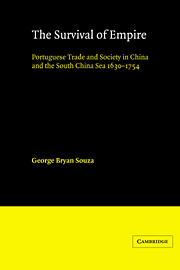Book contents
- Frontmatter
- Contents
- List of figures, maps and tables
- Glossary
- Notes on spelling and currency, weights and measures
- Preface
- 1 Maritime trade in Asia
- 2 Imperial foundations: the Estado da India and Macao
- 3 Population, personalities, and communal power
- 4 Country traders and Crown monopoly
- 5 Merchants and markets
- 6 Country traders and the search for markets
- 7 Imperial relations: Macao and the Estado da India
- 8 Imperial survival: Sino-Portuguese relations from Ming to Ch'ing
- 9 Macao, Companies and country traders: the other Europeans in China
- 10 Conclusion
- List of abbreviations and notes
- Primary Sources
- Bibliography
- Index
9 - Macao, Companies and country traders: the other Europeans in China
Published online by Cambridge University Press: 24 October 2009
- Frontmatter
- Contents
- List of figures, maps and tables
- Glossary
- Notes on spelling and currency, weights and measures
- Preface
- 1 Maritime trade in Asia
- 2 Imperial foundations: the Estado da India and Macao
- 3 Population, personalities, and communal power
- 4 Country traders and Crown monopoly
- 5 Merchants and markets
- 6 Country traders and the search for markets
- 7 Imperial relations: Macao and the Estado da India
- 8 Imperial survival: Sino-Portuguese relations from Ming to Ch'ing
- 9 Macao, Companies and country traders: the other Europeans in China
- 10 Conclusion
- List of abbreviations and notes
- Primary Sources
- Bibliography
- Index
Summary
Portugal's incorporation into the Habsburg Empire in the late sixteenth century involved the Estado da India in a world-wide imperial contest between the Habsburgs and the Protestant powers. The Netherlands, as the north Atlantic's premier naval and commercial power, lead the Protestant powers' attack upon the Portuguese in the East. Although the Dutch threat to Macao receded, the Portuguese were replaced in the pre-dominant commercial position in China by the European Companies and country traders.
Intrepid individuals employed by companies sailed from Holland for the Indonesian archipelago in search of obtaining spice supplies direct from Asian producers. These early Dutch companies encountered obstacles and conditions that led to the establishment of the VOC in the Netherlands in 1602. Almost immediately after the Dutch arrived in the East, Portuguese shipping en route from Macao to India and throughout the Indian Ocean and the South China Sea became the prey for superior Dutch naval forces. The isolated Portuguese outposts in the Spice islands were occupied by VOC forces in 1605. The Dutch were successful in their attack on Tidore and Ambon but were surprised by the subsequent Spanish counter-attack on Tidore and portions of Ternate, which the Spanish captured and held until their recall to the Philippines in 1662.
After their occupation of the Spice islands in 1605 and until their establishment at Batavia (Jakarta) on the island of Java in 1619, the VOC naval and land forces were superior in numbers to the Portuguese in the South China Sea and, possibly, in the entire Estado da India.
- Type
- Chapter
- Information
- The Survival of EmpirePortuguese Trade and Society in China and the South China Sea 1630–1754, pp. 213 - 225Publisher: Cambridge University PressPrint publication year: 1986

